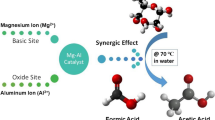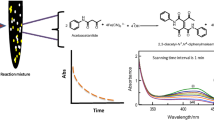Abstract
In this work, we showed that aquacobalamin (H2OCbl) undergoes decomposition in the presence of glucose oxidase and glucose under aerobic conditions at pH 6.3. This process is contributed by two reactions performed by glucose oxidase, i.e. (i) H2OCbl transformation to cob(II)alamin in the course of the reaction with reduced form of glucose oxidase, and (ii) hydrogen peroxide generation. Further reaction between cob(II)alamin and H2O2 results in macrocycle destruction. Although the reaction between H2OCbl and reduced glucose oxidase is slow, it is accelerated by several phenols and 1,4-benzoquinone. The most pronounced effect of 1,4-benzoquinone and hydroquinone can be explained by the formation of complexes with reduced glucose oxidase, which are more reactive toward H2OCbl than initial reduced glucose oxidase. 1,4-benzoquinone accelerates H2OCbl decomposition in glucose oxidase/glucose system as well.










Similar content being viewed by others
References
Dereven’kov IA, Salnikov DS, Silaghi-Dumitrescu R et al (2016) Redox chemistry of cobalamin and its derivatives. Coord Chem Rev 309:68–83. https://doi.org/10.1016/j.ccr.2015.11.001
Brown KL (2005) Chemistry and Enzymology of Vitamin B12. Chem Rev 105:2075–2149. https://doi.org/10.1021/cr030720z
Kräutler B (2005) Vitamin B12: chemistry and biochemistry. Biochem Soc Trans 33:806–810. https://doi.org/10.1042/BST0330806
Banerjee RV, Matthews RG (1990) Cobalamin-dependent methionine synthase. FASEB J 4:1450–1459. https://doi.org/10.1096/fasebj.4.5.2407589
Bridwell-Rabb J, Drennan CL (2017) Vitamin B12 in the spotlight again. Curr Opin Chem Biol 37:63–70. https://doi.org/10.1016/j.cbpa.2017.01.013
Watanabe F, Bito T (2018) Vitamin B12 sources and microbial interaction. Exp Biol Med 243:148–158. https://doi.org/10.1177/1535370217746612
Watanabe F, Yabuta Y, Tanioka Y, Bito T (2013) Biologically Active Vitamin B12 compounds in foods for preventing deficiency among vegetarians and elderly subjects. J Agric Food Chem 61:6769–6775. https://doi.org/10.1021/jf401545z
Rizzo G, Laganà AS, Rapisarda AMC et al (2016) Vitamin B12 among vegetarians: status, assessment and supplementation. Nutrients 8:767. https://doi.org/10.3390/nu8120767
Johns PW, Das A, Kuil EM et al (2015) Cocoa polyphenols accelerate vitamin B12 degradation in heated chocolate milk. Int J Food Sci Technol 50:421–430. https://doi.org/10.1111/ijfs.12632
Bajaj SR, Singhal RS (2020) Degradation kinetics of vitamin B12 in model systems at different pH and extrapolation to carrot and lime juices. J Food Eng 272:109800. https://doi.org/10.1016/j.jfoodeng.2019.109800
Watanabe F, Katsura H, Abe K, Nakano Y (2000) Effect of light-induced riboflavin degradation on the loss of cobalamin in milk. J Home Econ Jpn 51:231–234. https://doi.org/10.11428/jhej1987.51.231
Juzeniene A, Nizauskaite Z (2013) Photodegradation of cobalamins in aqueous solutions and in human blood. J Photochem Photobiol B 122:7–14. https://doi.org/10.1016/j.jphotobiol.2013.03.001
Ahmad I, Qadeer K, Hafeez A et al (2017) Effect of ascorbic acid on the photolysis of cyanocobalamin and aquocobalamin/hydroxocobalamin in aqueous solution: A kinetic study. J Photochem Photobiol A 332:92–100. https://doi.org/10.1016/j.jphotochem.2016.08.004
Ahmad I, Hafeez A, Akhter N et al (2012) Effect of Riboflavin on the Photolysis of Cyanocobolamin in Aqueous Solution. Open Anal Chem J 6:22–27. https://doi.org/10.2174/1874065001206010022
Kalisz HM, Hecht H-J, Schomburg D, Schmid RD (1990) Crystallization and preliminary X-ray diffraction studies of a deglycosylated glucose oxidase from Aspergillus niger. J Mol Biol 213:207–209. https://doi.org/10.1016/S0022-2836(05)80179-2
Hecht HJ, Kalisz HM, Hendle J et al (1993) Crystal structure of glucose oxidase from Aspergillus niger refined at 2.3 Å resolution. J Mol Biol 229:153–172. https://doi.org/10.1006/jmbi.1993.1015
Bankar SB, Bule MV, Singhal RS, Ananthanarayan L (2009) Glucose oxidase–an overview. Biotechnol Adv 27:489–501. https://doi.org/10.1016/j.biotechadv.2009.04.003
Wong CM, Wong KH, Chen XD (2008) Glucose oxidase: natural occurrence, function, properties and industrial applications. Appl Microbiol Biotechnol 78:927–938. https://doi.org/10.1007/s00253-008-1407-4
Leskovac V, Trivić S, Wohlfahrt G et al (2005) Glucose oxidase from Aspergillus niger: the mechanism of action with molecular oxygen, quinones, and one-electron acceptors. Int J Biochem Cell Biol 37:731–750. https://doi.org/10.1016/j.biocel.2004.10.014
Wohlfahrt G, Trivić S, Zeremski J et al (2004) The chemical mechanism of action of glucose oxidase from Aspergillus niger. Mol Cell Biochem 260:69–83. https://doi.org/10.1023/b:mcbi.0000026056.75937.98
Metosh-Dickey CA, Mason RP, Winston GW (1998) Single electron reduction of xenobiotic compounds by glucose oxidase from Aspergillus niger. Free Radic Biol Med 24:155–160. https://doi.org/10.1016/S0891-5849(97)00207-4
Bourdillon C, Denaille C, Moiroux J, Saveant J-M (1993) New insights into the enzymic catalysis of the oxidation of glucose by native and recombinant glucose oxidase mediated by electrochemically generated one-electron redox cosubstrates. J Am Chem Soc 115:2–10. https://doi.org/10.1021/ja00054a001
Nazhat NB, Golding BT, Alastair Johnson GR, Jones P (1989) Destruction of vitamin B12 by reaction with ascorbate: The role of hydrogen peroxide and the oxidation state of cobalt. J Inorg Biochem 36:75–81. https://doi.org/10.1016/0162-0134(89)80014-5
Salnikov DS, Makarov SV, Koifman OI (2021) The radical versus ionic mechanisms of reduced cobalamin inactivation by tert-butyl hydroperoxide and hydrogen peroxide in aqueous solution. New J Chem 45:535–543. https://doi.org/10.1039/D0NJ04231E
Swoboda BEP, Massey V (1965) Purification and Properties of the glucose oxidase from Aspergillus niger. J Biol Chem 240:2209–2215. https://doi.org/10.1016/S0021-9258(18)97448-X
Barker HA, Smyth RD, Weissbach H et al (1960) Isolation and properties of crystalline cobamide coenzymes containing benzimidazole or 5, 6-dimethylbenzimidazole. J Biol Chem 235:480–488
Stich TA, Buan NR, Brunold TC (2004) Spectroscopic and computational studies of Co2+corrinoids: spectral and electronic properties of the biologically relevant base-on and base-off forms of Co2+cobalamin. J Am Chem Soc 126:9735–9749. https://doi.org/10.1021/ja0481631
Salnikov DS, Dereven’kov IA, Makarov SV, Artyushina EN (2011) Reaction of hydroxocobalamin with glucose. Izv Vyssh Uchebn Zaved Khim Khim Tekhnol 54:43–46 ((in Russian))
Dereven’kov IA, Salnikov DS, Shpagilev NI et al (2012) Reactions of Cobinamide with Glucose and Fructose. Macroheterocycles 5:260–265. https://doi.org/10.6060/mhc2012.120884m
Schrauzer GN, Deutsch E, Windgassen RJ (1968) The nucleophilicity of vitamin B12s. J Am Chem Soc 90:2441–2442. https://doi.org/10.1021/ja01011a054
Funding
This work was supported by the Russian Science Foundation (Project No. 19-73-00147) to IAD.
Author information
Authors and Affiliations
Corresponding author
Ethics declarations
Conflict of interest
The authors declare that they have no conflict of interest.
Additional information
Publisher's Note
Springer Nature remains neutral with regard to jurisdictional claims in published maps and institutional affiliations.
Supplementary Information
Below is the link to the electronic supplementary material.
Rights and permissions
About this article
Cite this article
Dereven’kov, I.A., Makarov, S.V. & Makarova, A.S. Mechanism of aquacobalamin decomposition in aqueous aerobic solutions containing glucose oxidase and glucose. Reac Kinet Mech Cat 133, 73–84 (2021). https://doi.org/10.1007/s11144-021-01992-z
Received:
Accepted:
Published:
Issue Date:
DOI: https://doi.org/10.1007/s11144-021-01992-z




